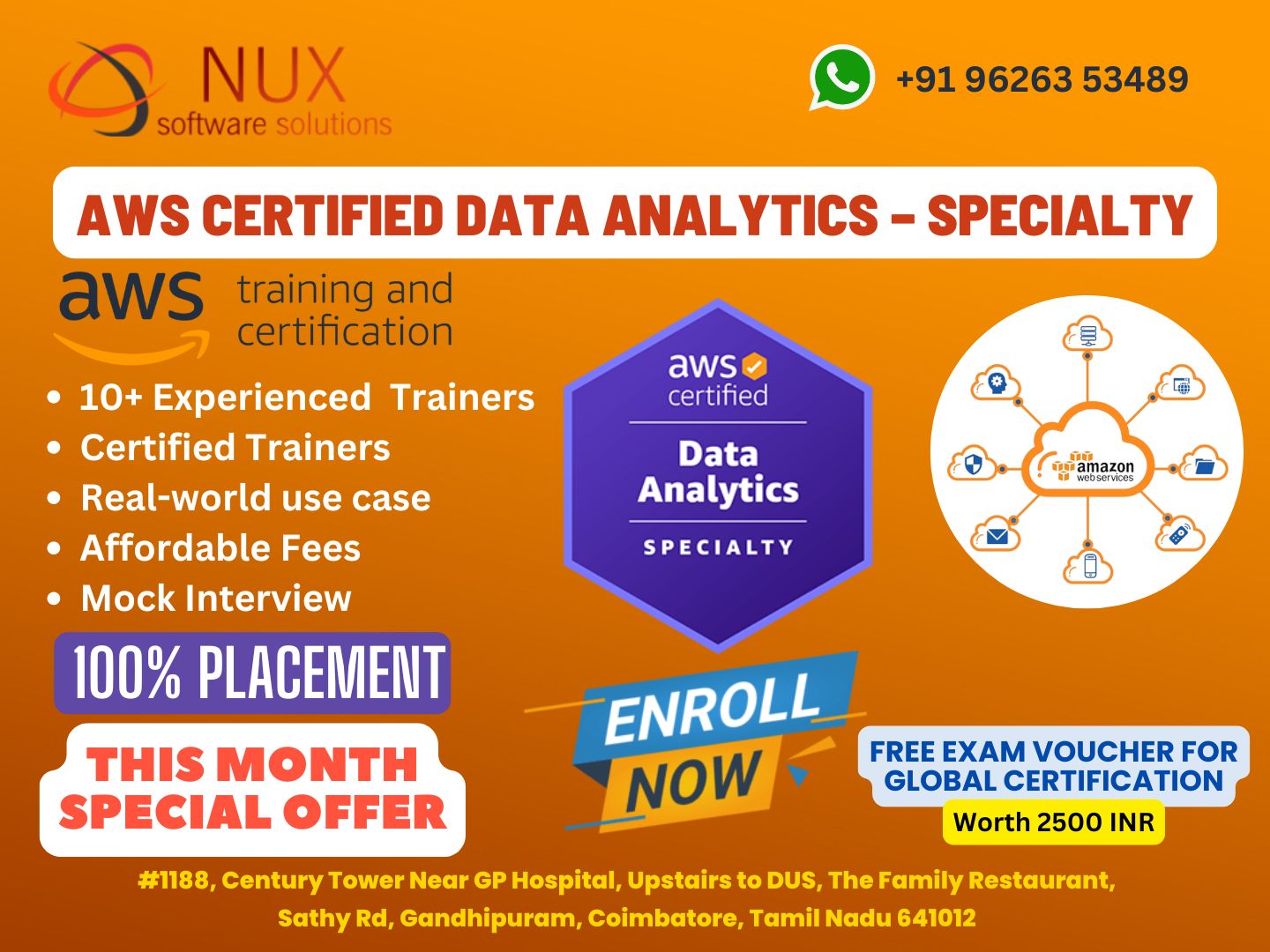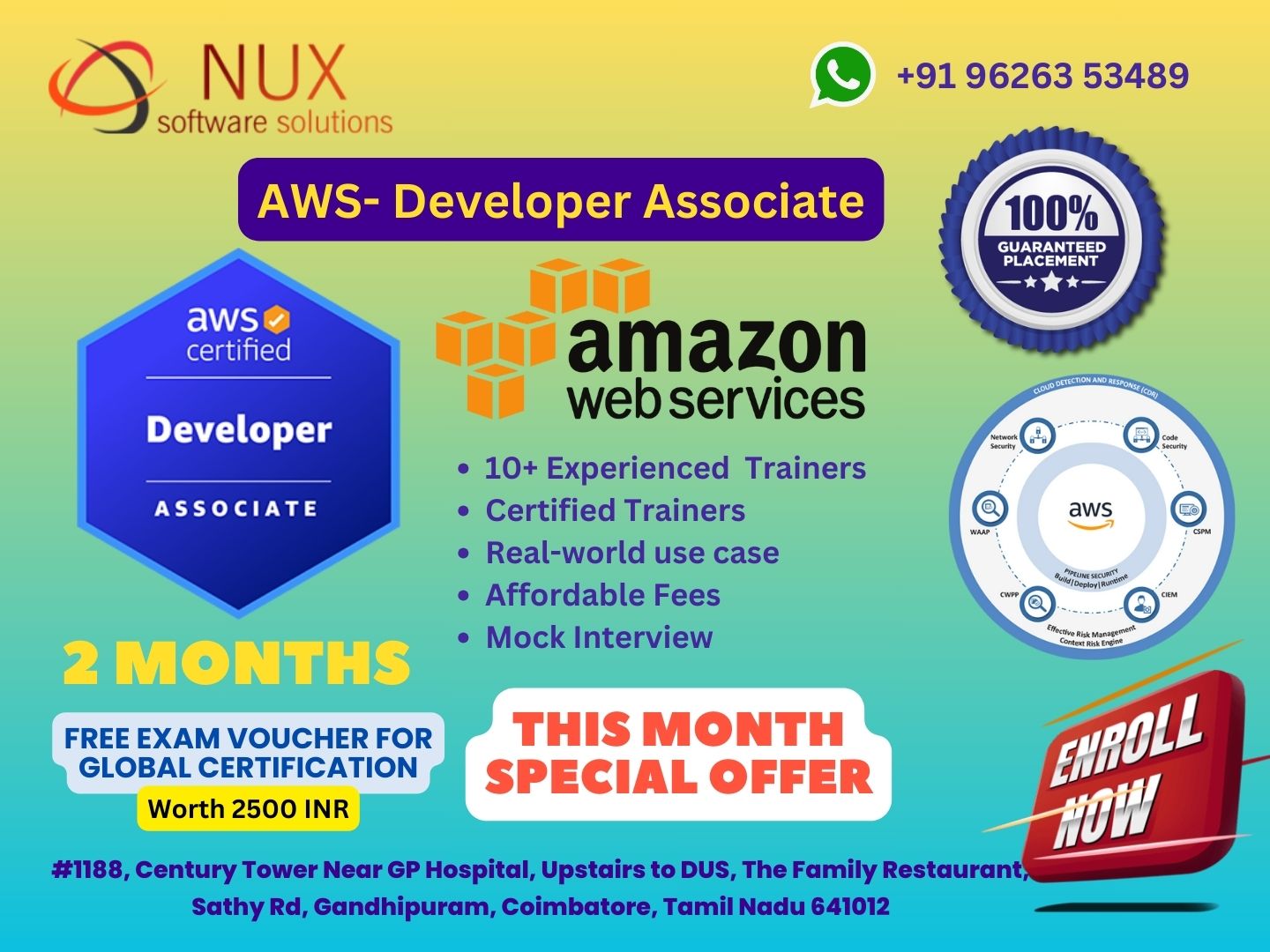AWS Solution Architect Associate – AWS SAA-C03

Become an AWS Solution Architect with Nux Software Solutions
Nux Software Solutions in Coimbatore is the top choice for thorough exam preparation for AWS Solution Architect Associate (SAA-C03). As a top AWS cloud training provider, our focus is on giving you the expertise and understanding required to succeed in the ever-changing field of cloud architecture.
AWS is a secure, reliable, and scalable cloud platform that enables businesses to innovate and reach their objectives. By utilizing resources from AWS such as computing capabilities, content distribution, and database storage, you can optimize processes, cut expenses, and boost development.
The AWS Cloud Training Program we offer
Our AWS cloud training program at Nux Software Solutions aims to give you a thorough comprehension of AWS architectural principles, services, and best practices.
Our skilled teachers will lead you in practical activities and authentic situations, making sure you’re ready to create and execute cloud solutions that are scalable, dependable, and budget-friendly.
Advantages of Our AWS Training
- Thorough Curriculum: Our classes include all the necessary subjects for the SAA-C03 test, such as AWS services, design, and recommended techniques.
- Skilled Teachers: Our instructors are seasoned experts in AWS and have a strong enthusiasm for educating.
- Hands-On Labs: Acquire hands-on experience with AWS services using our cutting-edge lab facilities.
Choose from a range of training options, such as classroom, online, and corporate training, to suit your schedule with Flexible Learning Options.
Assistance with Career Placement: Take advantage of our extensive network of industry partners and get help finding a job.
What makes Nux Software Solutions the preferred choice?
Unmatched experience in the industry: We have a demonstrated history of successfully training AWS professionals.
Dedication to Excellence: We offer top-notch training and support services. Our prices are affordable, making AWS training available to all.
Are you prepared to begin your AWS adventure?
Sign up for our AWS Solution Architect Associate training program right now.
AWS Solution Architect Associate Syllabus
Domain 1: Design Secure Architectures (30% of Exam)
Task 1: Create secure access to AWS resources:
In this task, you must ensure secure access to AWS resources across multiple AWS accounts by implementing appropriate access controls and management strategies. A strong understanding of AWS federated access and identity services, including AWS Identity and Access Management (IAM) and AWS Single Sign-On (AWS SSO), is also necessary.Area of Focus:
- Implementing AWS security best practices for users and root users, including multi-factor authentication (MFA).
- Using IAM users, groups, roles, and rules to create a customizable authorization strategy.
- Using AWS Security Token Service (AWS STS), role switching, and cross-account access, develop a role-based access control approach.
- Creating a security plan to manage security across many AWS accounts, using technologies such as AWS Control Tower and service control policies (SCPs).
- Choosing when to apply resource policies to AWS services.
- Determining whether it is appropriate to federate a directory service with IAM roles.
Task 2: Create secure workloads and apps
Area of Focus:
- Designing Virtual Private Cloud (VPC) designs with safety features like security groups, route tables, network access control lists (ACLs), and NAT gates.
- Developing network segmentation solutions that make use of public and private subnets.
- Increasing application security by integrating AWS services such as AWS Shield, AWS Web Application Firewall (WAF), AWS Single Sign-On (SSO), and AWS Secrets Manager.
- Using Virtual Private Network (VPN) or AWS Direct Connect to secure external network connections.
Task 3: Determine adequate data security procedures:
Area of Focus:
- Data encryption in transit using AWS Certificate Manager (ACM) and Transport Layer Security (TLS).
- Creating encryption key access regulations to retain control.
- Putting in place data backup and replication procedures.
- For increased security, rotate encryption keys and update certificates regularly.
Domain 2: Design Resilient Architecture (26% of Exam
The second domain focuses on creating durable, scalable, and fault-tolerant systems. You can construct architectures that can tolerate failures while maintaining performance and availability by understanding topics like scaling techniques, loosely coupled designs, fault-tolerant methodologies, and employing relevant AWS services.
Task 1: Create scalable and loosely linked architectures: This task entails creating scalable and loosely connected designs for flexibility and dependability.
Area of Focus
- Creating requirements-driven event-driven, microservice, and multi-tier architectures.
- Choosing acceptable scaling solutions for various architectural components.
- Choose the AWS services required to accomplish the loose coupling based on particular needs.
- Deciding when to use containers to deploy workloads.
- Recognizing instances that lend themselves to serverless technologies and behaviors.
- Recommend appropriate computing, storage, networking, and database technologies based on workload requirements.
Task 2: Create highly available and/or fault-tolerant architectures: In the second task, you are expected to build highly available and fault-tolerant systems that provide constant access to resources despite failures.
Area of Focus:
- Developing automated solutions to ensure the integrity of the infrastructure.
- Choosing the best AWS services to build highly available and resilient systems across AWS Regions or Availability Zones.
- Identifying key indicators to guarantee a high level of availability.
- Ensuring data durability and availability via measures such as backups.
- Choosing appropriate DR strategies to match business needs.
- Using AWS services to improve the stability of legacy programs and apps that were not meant for the cloud in the first place.
- Using purpose-built AWS services to meet a variety of workload requirements.
Domain 3: Design High-Performance Architectures (24% of Exam)
Task 1: Identify high-performance and/or scalable storage options:
Task 1 involves selecting storage systems that can meet high-performance and scalability requirements. It covers hybrid storage systems, storage services like Amazon S3, Amazon Elastic File System (Amazon EFS), and Amazon Elastic Block Store (Amazon EBS), and discusses the features of different storage types.Area of Focus:
- Selecting storage services and configurations that satisfy specific performance requirements.
- Choosing storage options that can efficiently expand to suit future development.
Task 2: Create high-performance, elastic computing solutions: In the second task, you have to focus on creating computing solutions that are both high-performing and elastic, allowing them to adapt to changing workloads.
Area of Focus:
- Workload decoupling to enable components to scale independently.
- Determining measurements and situations that will trigger scaling actions.
- Choosing appropriate compute alternatives, instance kinds, and resource sizes to fulfill business needs.
Task 3: Identify high-performance database solutions: The focus here is on choosing database systems that can provide high performance. It covers AWS' worldwide architecture, caching tactics, data access patterns, capacity planning, database connections, replication, and different database types and services.
Area of Focus:
- Setting up read replicas to meet business requirements.
- Creating database architectures that are optimized for performance.
- Choosing suitable database engines and types (Amazon Aurora and Amazon DynamoDB).
- Effectively integrating caching solutions.
Task 4: Develop high-performance and/or scalable network topologies: In the fourth task of domain 3, you’ll entail creating high-performance network topologies that can scale effortlessly. It includes Amazon CloudFront and AWS Global Accelerator edge networking services, network architecture design, load balancing, and network connection choices.
Area of Focus:
- Designing network topologies for various architectural types (for example, global, hybrid, and multi-tier).
- Choosing network configurations that will allow for future growth.
- Appropriate resource placement to fulfill business needs.
- Choosing appropriate load-balancing solutions.
Task 5: Identify high-performance data intake and transformation options: Here, the task aims to identify high-performance data input and transformation options. It includes services for data analytics and visualization, collecting data trends, data transfer services, data transformation solutions, secure access, and streaming data.
Area of Focus:
- Constructing and safeguarding data lakes.
- Creating structures for data streaming.
- Development of data transmission solutions.
- Putting successful visualization tactics into action.
- Selecting suitable computing alternatives for data processing.
- Setting up data intake and converting data across formats.
Domain 4: Design Cost-Effective Architectures (20% of Exam)
The last domain gives finishing to the AWS Solution Architect Syllabus and prepares you for the exam. The goal in this domain is to create designs that achieve a balance between performance and cost efficiency. It contains four tasks that are mentioned as follows:
Task 1: Create cost-effective storage options: In this task, the syllabus covers storage solutions that are both functional and cost-effective. It briefly explains access choices, AWS cost management service features, tools such as AWS Cost Explorer and AWS Budgets, etc.
Area of Focus:
- Creating storage plans depending on upload methods and frequency.
- Choosing adequate storage sizes for various workloads.
- Selecting the most cost-effective way of data transport to AWS storage.
- Effectively managing S3 object lifecycles.
- Choosing appropriate backup and archive options.
- Choosing the best data migrating service for storage services.
- Choosing suitable storage tiers based on workload requirements.
Task Statement 2: Create cost-effective computing solutions: The aim here is to build computing solutions that deliver outstanding performance while being cost-effective. It delves into AWS cost management service features, AWS global infrastructure, purchase choices such as Spot Instances and Reserved Instances, etc.
Area of Focus:
- Choosing load-balancing solutions that are suited for various use scenarios.
- Identifying cost-effective scaling strategies for elastic workloads.
- Determining the best AWS computing services depending on workload requirements.
- Choosing appropriate instance families and sizes.
- Creating instances to fulfill availability needs.
Task 3: Create cost-effective database solutions: In this task, you’ll focus on developing database systems that provide excellent performance at a low cost. It discusses AWS cost management service features, caching techniques, data retention rules, database capacity scheduling, database engines, and replicating, database types and services, and database types and services.
Area of Focus:
- Creating appropriate database backup and retention procedures.
- Choosing the best database engine for a given set of needs.
- Choosing the most cost-effective AWS database services depending on workload requirements.
- Determining the most cost-effective database types.
- Efficiently migrating database structures and data.
Task 4: Create cost-effective network topologies: This task might be the same as task four for the previous domain, but the objective here is slightly different. You have to create network topologies that are both high-performing and cost-effective. It discusses AWS cost management service features, load balancing ideas, NAT gateways, network connection options, network routing and peering, network resources such as DNS, and other topics.
Area of Focus:
- Choosing suitable NAT gateway types to save expenses.
- Choosing appropriate network connections for various circumstances.
- Setting up network paths to save transfer costs.
- Identifying the requirements for content delivery networks (CDNs) and edge caching.
- Examining current workloads for network improvements.
- Choosing suitable network device throttling and bandwidth allocation algorithms.


